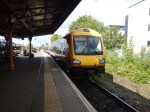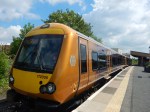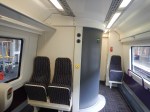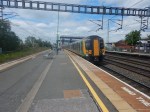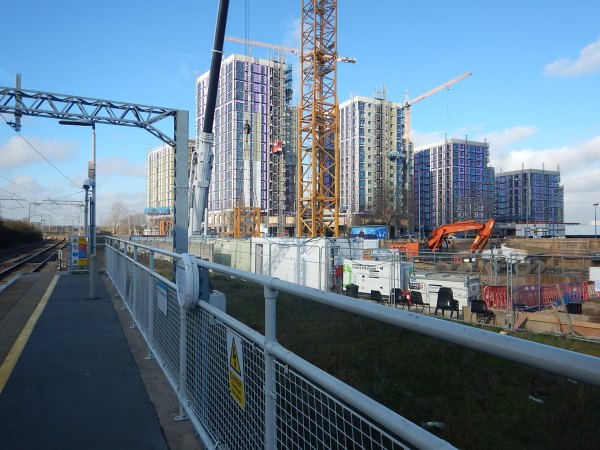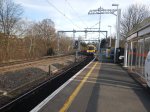UK’s First 100mph Battery-Diesel Hybrid Train Enters Passenger Service
The title of this post, is the same as that of this article on ITV.
These are the first three paragraphs.
The UK’s first 100mph battery-diesel hybrid train is entering passenger service to cut carbon emissions and boost air quality.
It was developed by adding a powerful battery to a 20-year-old diesel train to reduce fuel consumption and CO2 emissions by 25%, according to owner Porterbrook.
The firm added that the two-carriage train, named HybridFLEX, also provides a 75% decrease in noise and a 70% decrease in nitrogen oxide.
The battery-diesel hybrid transmission is from MTU, who are a Rolls-Royce company and they go further with this press release which is entitled World Premiere: MTU Hybrid PowerPack From Rolls-Royce Enters Passenger Service.
This is the first paragraph.
Rolls-Royce, Porterbrook and Chiltern Railways are making rail history together with a climate-friendly world premiere: A hybrid diesel-battery-electric train that reduces CO2 emissions by up to 25% entered passenger service in the UK today for the first time. The so-called HybridFLEX train is powered by two mtu Hybrid PowerPacks and is operated by Chiltern Railways on the route between London Marylebone and Aylesbury. Together with the leasing company Porterbrook and Chiltern Railways, Rolls-Royce has converted a Class 168 DMU into the HybridFLEX train. The partners are proving that existing rail vehicles can be used in a climate-friendly way without the need to install complex and expensive new infrastructure. It is the world’s first regular passenger operation with mtu Hybrid PowerPacks, of which 13 have already been ordered.
This is significant for the railways of the UK.
The train that has been converted is a Class 168 train, which itself had been converted from a Class 170 train, when it transferred to Chiltern Railways in 2016.
I think this means that all Bombardier Turbostars in Classes 168, 170, 171 and 172 can probably be fitted with MTU Hybrid PowerPacks.
That is the following numbers of trains and cars.
- Class 168 – 28 trains – 86 cars
- Class 170 – 139 trains – 372 cars
- Class 171 – 20 trains – 56 cars
- Class 172 – 39 trains – 93 cars
Note.
- This totals to 226 trains and 607 cars.
- As each car has an engine, this will be an order of 607 PowerPacks, if all trains were to be converted.
This could certainly help to meet the Government’s aim of getting rid of all diesel only trains by 2040.
Can The CAF Civities Be Converted?
There are three Classes of CAF Civity diesel multiple units; 195, 196 and 197, all of which have Rolls-Royce MTU engines.
Could these be converted to hybrid operation by the swapping of the current diesel engines for MTU Hybrid PowerPacks?
I would suspect they could, as the CAF Civity trains might have been designed after MTU disclosed plans of the MTU Hybrid PowerPack to train builders prior to its announcement in September 2018.
Conclusion
MTU Hybrid PowerPacks could go a long way to eliminating diesel-only trains on UK railways. They could even run the diesels on Hydrotreated Vegetable Oil (HVO) to lower their carbon-footprint further.
A Trip Around The West Midlands
Today, I did a trip around the West Midlands, using five different trains.
Tain 1 – 19:10 – Chiltern – London Marylebone To Leamington Spa
This was one of Chiltern’s rakes of Mark 3 coaches hauled by a Class 68 locomotive.
I like these trains.
- They are comfortable.
- Everybody gets a table and half sit by a big window.
- There is more space than Virgin Train’s Class 390 trains.
- They may be slower, but they are fast enough for most journeys I make.
The train arrived seven minutes late at Leamington Spa at 11:32.
Train 2 – 12:02 – West Midlands Trains – Leamington Spa To Nuneaton
This is a new West Midlands Trains service, via the new station at Kenilworth and Coventry.
The trains are Class 172 trains, that used to run on the Gospel Oak to Barking Line.
Note.
- The have been repainted and refreshed.
- The seat cover on the driver’s seat is a relic of the London Overground.
- The train now has a toilet.
The train was about half-full and I got the impression, that the new service had been well-received.
The train arrived on time at Nuneaton at 12:38.
Train 3 – 12:54 – West Midlands Trains – Nuneaton to Rugeley Trent Valley
The train was a Class 350 train and it arrived eight minutes late at 13:29.
These pictures show Rugeley Trent Valley station.
It is very minimal with just a shelter, a basic footbridge and no information on how or where to buy a ticket.
Passengers deserve better than this!
Train 4 – 13:43 – West Midlands Trains – Rugeley Trent Valley to Birmingham New Street
This is a new West Midlands Trains electric service.
Compared to the Leamington Spa to Nuneaton service, passengers were spread rather thinly in the train.
The train was a Class 350 train and it arrived five minutes late at 14:44.
Train 5 – 15:55 – Chiltern – Birmingham Moor Street to London Marylebone
Another comfortable Chiltern Railways train back to London, which arrived four minutes late at 17:47.
Customer Service
Customer service and especially that from West Midlands Trains was rather patchy.
- Leamington Spa station was rebuilding the entrance, but staff were around.
- Nuneaton station was very quiet.
- Rugeley Trent Valley station needs a lot of improvement.
- The two Birmingham City Centre stations were much better.
I actually had to travel ticketless from Rugeley Trent Valley to Birmingham New Street, as the Conductor on the train didn’t check the tickets.
But Virgin Trains were very professional at Birmingham New Street.
Service Pattern
I have some observations on the service patterns.
- For comfort reasons, I would prefer that Chiltern ran Mark 3 coaches and Class 68 locomotives on all Birmingham services.
- In the future, it looks like Leamington Spa and Nuneaton needs at least a half-hourly service.
- There definitely needs to be more services on the Chase Line.
There also is a serious need for staff and better facilities at Rugeley Trent Valley station.
No-one even a hardened member of the SAS would want to spend thirty minutes changing trains there on a blustery and cold winter’s day.
Conclusion
I tried two new services today, that started on the May 2019 timetable change.
- A diesel service between Leamington Spa and Nuneaton via Kenilworth and Coventry.
- An electrified service between Rugeley Trent Valley and Birmingham New Street.
The first would appear to be what passengers want, but the second needs a bit of promoting.
Breeze Hydrogen Multiple-Unit Order Expected Soon
The title of this post is the same as that of this article on Railway Gazette.
This is the first paragraph.
Alstom Transport is hopeful of confirming an order before the end of this year for its Breeze hydrogen multiple-unit trains being developed in partnership with leasing company Eversholt Rail, suggesting that the first trains could enter service ‘as early as 2022’.
It then goes out to fill out some of the thinking behind the Alstom Breeze hydrogen-powered train.
The Breeze Is A Stop-Gap
Alstom are quoted as indicating the Breeze is an interim solution, until the next generation of train is available.
But after a ride to Southend recently in a Class 321 Renatus, I’m sure that the ride and passenger acceptance will be of a high standard.
And that’s what counts. Hydrogen is only the train’s personal power supply.
Alstom Are Not Building A Suburban Trundler
The Alstom Coradia iLint is not an exciting train.
- It has a cruising speed of 87 mph.
- It has a range of 370-500 miles.
- It has a noisy mechanical transmission.
- It always runs on hydrogen-power.
- The prototypes have covered 100,000 km.
In my view, it is very much a first generation compromise design.
The article says more about the Alstom Breeze.
- It has a slightly faster cruising speed of 90 mph
- The Breeze will have 50% more power than the iLint. Does this mean better acceleration and/or a longer and heavier train?
- It will have a 1,000 km range.
- It will have regenerative braking to the train’s batteries.
- It will have a new AC traction package, as does a Class 321 Renatus. So will the two systems be the same? Or at least similar?
I am also fairly sure, the train will be able to use electrification of both 25 KVAC overhead and 750 VDC third-rail, as Class 321 trains can now!
Train Capacity
This is said about train capacity.
Despite the loss of some seating space, each set of three 20 m vehicles would provide slightly more capacity than a two-car DMU with 23 m cars which it would typically replace.
The Class 172/0 trains, that are two-car 23 metre diesel multiple units, have 124 seats.
In Hydrogen Trains Ready To Steam Ahead, I estimated that a three-car Alstom Breeze would have a seating capacity of around 140 seats, with the ability to perhaps take an additional 160 standees.
So was my seat estimate fairly good? I also think, that as the Breeze has been designed with bags of grunt, I suspect that the basic train could be increased in size by adding extra trailer cars.
After all, the legendary Class 442 train is a five-car train, with a power-car in the middle. South Western Railway, think they are worth pulling out of the scrapyard and refurbishing to run expresses between Waterloo and Portsmouth.
I am fairly certain, that Alstom can create a five-car Class 321 Breeze with the following characteristics.
- A capacity of about three hundred seats
- A smaller three-car train would have 140 seats.
- A near-100 mph top speed on hydrogen-power.
- A 100 mph top speed on electrification.
- A 1000 km range on hydrogen.
- Regenerative braking to an on-board battery.
- The ability to use 25 KVAC overhead and/or 750 VDC third rail electrification.
The trains could have the ability to run as pairs to increase capacity.
The train would be ideal for the following routes.
- Liverpool and North Wales via Chester
- Norwich and Derby
- Newcastle and Carlisle
- Preston and Carlisle via Barrow
- Cardiff and the South Coast of England
- Borders Railway
- Southampton and Ashford
- Waterloo and Exeter
All of these routes have partial electrification, which would reduce the amount of hydrogen needed to be carried around.
Now that is an interesting multi-variable calculation!
Hydrogen Infrastructure
Alstom seem to be developing infrastructure solutions to supply hydrogen for fleets of ten or more trains, which could be shared with other applications. The obvious one could be where a train depot and a fleet of buses share a facility in say a large city like Exeter, which has an extensive diesel train network.
The article also says this about the source of hydrogen.
Ideally, the trains would use ‘green’ hydrogen manufactured by electrolysis using surplus renewable energy rather than ‘brown’ hydrogen from steam methane reforming.
I agree wholeheartedly with that!
Delivery In 2022?
Consider what has already been achieved in other projects.
- Alstom have proved they can generate enough electricity to power a practical train.
- Eversholt have proved that you can turn Class 321 trains into comfortable and efficient 100 mph Class 321 Renatus trains for routes up to a hundred miles.
- Several classes of Mark 3-based electrical multiple units have been re-engined with AC traction, including the Class 321 Renatus.
- Engineers all over the UK have modified Mark 3-based coaches and multiple units to create better and more-efficient trains.
Helping delivery of the project, is a legacy of drawings and philosophy from British Rail Engineering.
If Alstom say 2022, I believe that that could be a feasible date.
Conclusion
The ghost of British Rail Engineering is certainly a benign one allowing all sorts of worthwhile development paths.
Irish Rail And Porterbrook Order MTU Hybrid PowerPacks
The title of this post is the same as that of this this article on the International Rail Jotnal..
This is the first paragraph.
Irish Rail (IE) and British rolling stock leasing company Porterbrook have signed contracts with Rolls-Royce for the supply of 13 MTU Hybrid PowerPacks, the first firm orders for the hybrid rail drives.
Other points are made in the article.
- IE has ordered nine PowerPacks for Class 22000 trains. If the technology works they intend to convert all 63 trainsets, which will need 234 PowerPacks, as each car has a diesel engine.
- Porterbrook has ordered four for Class 168 and Class 170 trains.
- The PowerPacks will be delivered between mid-2020 and 2021.
- The MTU engines are built to EU Stage 5 emission regulations.
- The PowerPacks can switch to battery power in stations and sensitive areas.
- Under battery power, noise is reduced by 75 % and CO2 emissions by up to 25 %
- Operating costs are significantly reduced.
- The PowerPacks have regenerative braking, thus they reduce brake pad wear.
- Due to electric power, the trains have been acceleration, which may reduce journey times.
It seems that passengers, train operating companies, train leasing companies and those that live by the railway are all winners.
If the concept works reliably and meets its objectives, I can see MTU selling a lot of Hybrid PowerPacks.
Which Operators Will Be Used For Trials?
This is a valid question to ask and I’ll put my thoughts together.
Irish Rail Class 22000 Train
These trains only run in Ireland with one operator;Irish Rail, so they will be used for trials.
As each car has one MTU diesel engine and Irish rail are stated in Wikipedia as wanting to run three-car and six-car sets, could they be converting one train of each length?
British Rail Class 168 Train
All the nineteen Class 168 trains of various lengths are in Chiltern Railway’s fleet, they will be the trial operator.
Chiltern also have nine two-car trains, which could be ideal for trial purposes as they will need two Hybrid PowerPacks.
British Rail Class 170 Train
Porterbrook own upwards of thirty two-Car Class 170 trains with CrossCountry, Greater Anglia and West Midlands Trains.
As Greater Anglia and West Midlands Trains are replacing their Class 170 trains, this means that CrossCountry will soon be the only user of two-car units.
The four two-car trains from Greater Anglia, will be going to Trains for Wales (TfW).
TfW currently has thirty two-car Pacers in its fleet, which must be replaced by the end of 2019.
TfW is bringing in the following trains.
- Nine four-car Class 769 trains from Porterbrook.
- Eight three-car Class 17 trains from Greater Anglia
- Four two-car Class 17 trains from Greater Anglia
This is a total of sixty-eight cars.
So TfW are replacing a load of scrapyard specials with quality, more powerful trains, with approximately 13 % more capacity.
TfW are proposing to use the Class 170 trains on the following routes.
- Heart of Wales line (from 2022)
- Regional services between South and West Wales
- South Wales metro lines – Ebbw Vale/Maesteg (until 2022)
- Crewe-Shrewsbury local services (from 2022)
There is a mixture of routes here and it would be a good trial,
Other Trains
If the MTU PowerPack proves successful and leads to widespread conversion of the Class 168 and Class 170 fleets, will we see the twenty Class 171 trains and thirty-nine Class 172 trains converted to hybrid power?
Conclusion
It looks like a good solid project to me!
